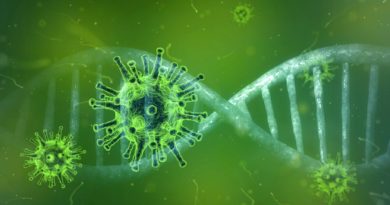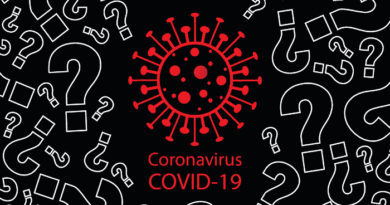Communicating About COVID-19 | News Center
In a world where conspiracy theories and political polarization abound, how does one effectively pull off double duty at battling against both the spread of COVID-19 and misinformation about it?
For answers, we turned to Rebecca Rice, a UNLV Greenspun College of Urban Affairs professor who specializes in crisis communication.
As the pandemic took the world by storm, Rice volunteered to document the experience for posterity. She’s currently working on a study that examines how municipal governments and public health agencies are gathering and sharing coronavirus data with the public, ways to make COVID-19 statistics and prevention measures easier for laypeople to interpret and understand, and how these agencies can gain the public’s trust and buy-in as we move into the vaccination phase.
Here, Rice offers a glimpse into the intricacies of coordinating an emergency response, shares observations and lessons we can learn along the way from the ongoing COVID-19 crisis, and explains how and why both citizens and authorities should reshape their definitions of success.
What are you studying?
My current research is about emergency collaborations during COVID-19. I’m studying how people from different organizations communicate to coordinate the COVID-19 response in their local community.
This has involved several big communication challenges: first, the need to be physically distanced has forced us all to create new virtual communication routines to stay in touch. Second, COVID has been a big challenge for public information sharing and we are now entering month 9 of having to share clear information with the public about the risks and staying safe.
I have been conducting this research using ethnography, which is all about observing people as they go about their work and taking really rich notes about everything that is happening in “the scene” of that organization. Ethnography captures all the good stuff — who said what, what emotions seemed to be present, the humor of workplaces, the drama, the misunderstandings, and the researcher’s interpretations. To do this, I’ve been observing the daily meetings of emergency organizations throughout the pandemic. These meetings are all virtual, and I’ve followed those up with interviews with the people involved to get their perspective on the communication technologies used, the challenges with public communication, and their unfolding understandings of COVID-19 over time. I hope this research will ultimately contribute to our understanding of how technology was used to communicate during crises, and can also show us something about organizational learning and understanding during a crisis.
<!–
How does crisis communication surrounding the COVID-19 pandemic differ from the response to other situations you’ve experienced/studied?
The main difference has been that other emergencies tend to be contained — a natural disaster response lasts as long as the natural disaster is going on. So, for a wildfire people may be working for one to two weeks to put out the blaze. COVID has been such a long response; usually by now communities would be looking at recovering from the emergency. With COVID, communities have had to think about response to the emergency and recovery, especially economic recovery, at the same time.
What are some of the key obstacles that governments and public health agencies face when communicating with citizens about the pandemic?
A big challenge has been that safety guidelines have evolved. In March, we were told that we didn’t need masks and they should be saved for health care workers. We didn’t even really tell people to stay far apart right away, just that they shouldn’t touch. The move from using hand sanitizer and wiping down surfaces to also considering that the virus moves through the air meant changing the guidance. The science and the public messaging are happening simultaneously, so the messaging has been created as knowledge changes. This is a challenge because communicating with clarity is a big need during any emergency, but the clarity hasn’t always been there.
How does Southern Nevada’s COVID-19 crisis communication situation differ from other areas?
Southern Nevada isn’t a research subject of my current study. But, based on general knowledge, I can say that it has a couple of unique challenges. I think like many areas where jobs are supported by tourism, the economic repercussions are really felt here. That’s led to tensions: how much do we encourage people to come? What steps should locals be taking to stay safe? What about tourists? And this also makes it harder to see what our level of infection is because people come in and out of the area quickly.
Why is it important to make COVID-19 data available to the public and why is it important to explain how it should be interpreted?
I think with a pandemic, people really crave information. If you are lucky enough to be sitting in your home staying safe, and until you know someone personally who is impacted, it can feel difficult to grasp the scale of what is happening. That’s why we’ve seen so much of a focus on the case count, the positivity rate, the number of people tested, and so on. It’s really important that crisis communication puts context around all these numbers. People are natural storytellers, so we want to know the story of COVID in our community. It’s not just about the number of people infected, we also want to know how people are getting sick, and how we are doing as a whole. Are the numbers getting better or worse?

<!–
I think people also want to be optimistic, so we tend to think “that can’t happen to me” or “I’m doing enough social distancing, I probably won’t get sick.” It’s important to communicate to the public that a wide range of people are getting really sick, and that even small gatherings can lead to big consequences. On the other hand, “risk fatigue” is a big problem — we’ve been told to stay apart from other people for over eight months now. If we ask people to be totally perfect and never see anyone outside of their household, I think people are more likely to throw their hands up and say, “I can’t do this perfectly so I’m not going to try.” So, in that sense, giving people options (for example, gathering outside) is a good way to give the public confidence that this won’t last forever and we can do what it takes to stay safe.
Based on your research, what are some strategies that governments, public health organizations, and other community partners/agencies can employ to make public communication about COVID-19 easier? Have you developed any best practices that could help agencies craft strong messages as we move out of the fact-finding, research, and prevention stages and into the vaccine phase?
Sharing data with the public has been a big challenge. It’s not simple to get the case numbers to the public — it requires coordination with hospitals, testing sites, labs, and other organizations we might not think of, for example, long term residential care facilities and universities. Building the communication infrastructure around that in some ways started from the ground up for most communities in March.
An important strategy is getting everyone to collaborate to talk about how we will share information, which might involve creating systems to protect patient privacy, making sure we are all compiling the same metrics, and checking for overlaps in the data. This has been a huge job but it’s really important as the public looks at the data and tries to figure out if the data shared can be trusted.
For the vaccination phase, I think agencies should start talking about the vaccines now, as soon as possible, to get people information about what will likely happen when the vaccine is out. For example, start preemptively answering questions such as where people can go to get inoculated and whether the agency is already doing anything to prepare for the vaccine rollout like training staff, gathering supplies, and so on. Also, the CDC is working on guidance about who should get the vaccine first, but states will have to make the ultimate determinations for their citizens;therefore, providing information about that process is valuable for the public right now. It can feel challenging to talk about vaccines still in clinical trials, but I think any sort of contextualization that can be done now will help the public to feel more confident getting the vaccines later.
Do you have advice on ways to reach members of the public who believe COVID-19 is a hoax or who are skeptical of science in general?
A challenge with conspiracy theories is that every new piece of information gets incorporated into the conspiracy. You can’t argue with a conspiracy theorist by offering them new scientific information if the overarching narrative of the conspiracy is that scientists can’t be trusted. Unfortunately, the focus might have to be on 1) people who believe the science and are ready for the vaccine, and 2) people who are on the fence or a bit apprehensive about the vaccine but could be persuaded to get it. We might not be able to get people who believe COVID is a hoax to go get the vaccine. But if we can get people who are uncertain to feel confident going to get the vaccine, that will make a big difference.
That’s why talking about the vaccine now is so important. For example, common refrains among some of those middle ground folks are things like “I can’t trust a vaccine developed this fast” or “I’ll just let some other people get it first and see how they do.” Talking about how the vaccine was developed, any side effects that have been documented, and what has been done to ensure safety will help people to trust it. And I think after the first round of people get vaccinated, collecting and sharing their stories about their experiences will be key. If we can see that those people are protected and able to get back to normal, that will be a huge incentive for other people to follow suit.
Though your research is ongoing,have any of the findings so far led you to shift the guidance you provide on crisis communications?
One interesting observation so far is that it’s hard to tell what a “successful” response to COVID really looks like. You might think, “No, it’s obvious. If there were very few cases and deaths, that’s a success.” But COVID, like other emergencies, also involves trying to understand our natural world and manage that world. This has led to a bit of a dilemma where some communities might have felt they were successful early on, but it also becomes a question of luck — maybe COVID never really took hold and surged in those communities and that’s why they looked successful. Additionally, as the pandemic continues we have to grapple with the questions about whether we should keep doing what we’ve been doing since March, or learn and adapt. I’ve started writing about this in my recent research article about identifying organizational routines that create resilience to crises. Instead of thinking about success as the absence of failure, I wonder how we can define success in terms of concrete actions we take to avoid failures.
*** This article has been archived for your research. The original version from Google News can be found here ***


